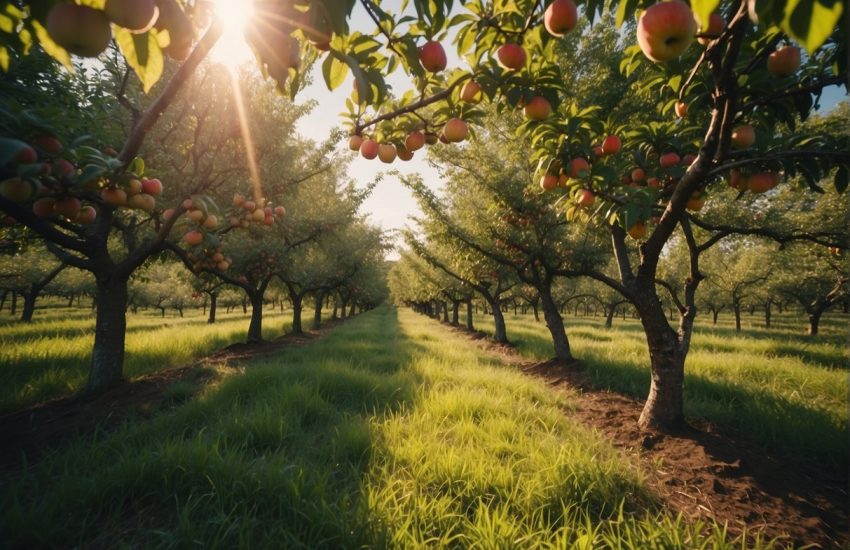7 Best Peach Trees To Grow In San Antonio
It should be noted that a majority of nurseries in the San Antonio area have already received their shipment of fruit trees for the year. You can plant container-grown plants at any time of the year, but now would be a good time to plant them.
A variety of fruit species can be grown in this region, some of which require special care to produce a reasonable amount of fruit while others are easier to grow.
Peaches are one of the favorite fruits in this area, but they also require a considerable amount of attention, including weekly spraying to ensure they do not develop blemishes.
The nectarines are the same as peaches without the fuzz, and due to the smooth skin, they are even more difficult to keep free from fungal infections and insect damage.
You should select varieties with early maturation in order to increase your chances of success. Insects, squirrels, fungi, and diseases are less likely to attack your tree because there will be less time for them to attack.
A couple of my favorites are Junegold and Texroyal. I would also recommend Texstar and Florida King early in the season.
I would recommend La Feliciana, which matures in June and is one of the best freestone varieties. I would recommend Armking to anyone looking for a challenge in his or her life.
Melba or Belle of Georgia are good choices if you want to try a white peach. White peaches do better when they have a cold winter.
The Red Baron is actually an ornamental type of peach. This particular peach has flowers that are quite beautiful and last for quite some time. My fruit is of high quality, but it is late, and I never seem to get as much as the squirrels.
Crimson Rocket™ Peach Tree
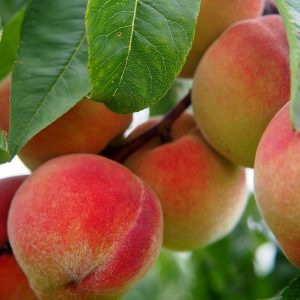
Do not think there is enough room in your yard to plant a peach tree. However, did you know that this is not the case? The answer is yes!
It’s all about the Crimson Rocket and it will shoot straight up into the sky, with a juicy payload attached!
Prunus persica ‘KV930455’, or the Crimson Rocket Peach Tree, is a perfect plant for urban gardens, patio containers, and balcony planters.
You won’t have any problem filling your kitchen with a delectable harvest without taking up too much space!
The Crimson Rocket tree has a much tighter profile and shorter stature than larger peach trees, but still produces the same great yields as larger trees.
And do you know what’s better, they don’t even require pollinating. There is only one peach tree that will yield arm loads of big, sweet, juicy peaches.
You will be able to harvest your first crop one to two years after planting them, and they will grow 1-2 feet each year!
In addition to being easy to grow, these Peaches are large, freestone, firm, and they ripen early in the season. In fact, the trees are so small that you could have a small orchard of Crimson Rocket Peach trees in your backyard.
Hale Haven Peach Tree
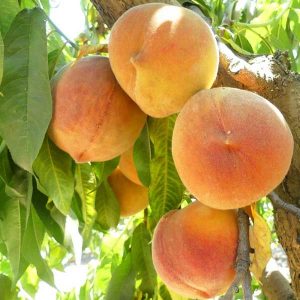
If you want to enjoy homegrown peaches over the winter, then you should certainly consider adding a Hale Haven Peach tree (Prunus persica ‘Hale Haven’) to your landscape.
The self-pollinating trees will be able to produce a large fruit set on their own without the need for any other plants.
It’s always a good idea to add more than one variety, or others, in order to boost your production up and over the top!
This is one of those special peaches that are round and large. On the bright golden-yellow backdrop of these earrings is a pretty red blush. This fruit is very tasty and has a wonderful aroma.
It is an excellent variety for canning due to the firm flesh of the fruit. Hale Haven’s soft, melting yellow flesh is known for the fact that it can withstand freezing temperatures as well.
Vivid Peach Tree
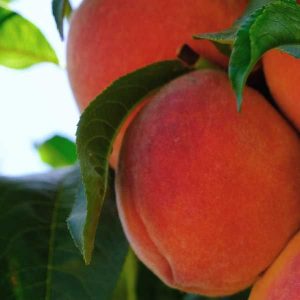
Vivid Peach Tree (Prunus persica ‘Vivid’) is considered to be one of the prettiest varieties of peaches available on the market today, with flesh that is perfectly crimson red!
The beautiful spring blooms of this plant are complemented by its attractive fruit and a good autumn color, making this a life-long favorite ornamental edible.
Your tree will be illuminated with luminous blooms in blooms of stunning pink hues brightening up the whole tree as well as attracting a wide range of pollinators.
It seems simple, but this tree will make any tree in your yard look stunning.
Also, the juicy, luscious taste of these peaches makes me want to eat them all the time. It is a good all-around peach with a high-quality flavor and is a good all-around peach.
Fans call it ‘the perfect peach’ for a reason, and it is not hard to understand why. They can also be used in home-made preserves, pies and cobblers that make excellent fresh-eating peaches.
In terms of preparation, their freestone pits easily separate from the flesh when pulled out of the ground.
Vivid Peach trees are so productive that you’ll love them! Not only do they produce reliably, but they are also easy to care for and self-pollinating!
During the midseason, the fruit ripens and you are rewarded with loads of bright red fruit with a juicy yellow pulp.
Canadian Harmony Peach Tree
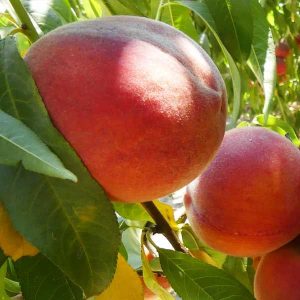
Make your edible landscape stand out with a self-pollinating peach tree! If you have never tasted your own homegrown, tree-ripened fruit, then you should definitely give it a shot.
The Canadian Harmony Peach tree (Prunus ‘Canadian Harmony’) is a productive and beautiful tree, even if you live in a colder region.
Unlike other varieties, this one blooms a bit later, which reduces the risk of late spring frosts affecting your harvest.
There are also a number of different ways in which you can use the Canadian Harmony fruit because of its well-balanced flavor.
In actuality, this is an “all-arounder” that can be applied to a wide variety of peach-related applications.
This is one of the juiciest and most delicious fruits I have ever eaten. During this time of year, you can enjoy large, firm peaches fresh or freeze them for use later. Since the pits can be easily removed, you will have an easy time preparing the peaches.
Lemon Elberta Peach Tree

It is a super upgrade from the already incredible Elberta Peach Tree to the Lemon Elberta Peach Tree (Prunus persica ‘Lemon Elberta’).
Flesh is brilliant yellow, fuzzy and tan when ripe, with a slight red blush, and the skin is brilliant yellow, as well.
There is no doubt that this is one of the best fresh eating peaches available.
This tree is exceptionally productive and the fruit has firm flesh, incredible flavor, and high yields, making it a highly valuable tree.
Freestone yellow peaches are excellent for cooking, preserving, freezing, and baking.
They are also excellent for eating raw. There is also the possibility of canning this variety as well because the fruit is nice and firm. You will get thick, meaty slices that you can dry or dehydrate as a great snack when you are hungry.
Bounty Peach Tree
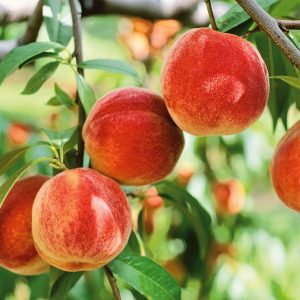
When the time comes for you to harvest your Bounty Peach Tree (Prunus persica ‘Bounty’), make sure you tell your friends and family.
Hosting a picking party will not only allow you to view the harvest, but also ensure that much of it will be eaten that day or in the days to follow.
This tree is very beautiful. It is a Bounty Peach tree. Dark green, long, slender leaves add a subtle touch of tropical flair to the pot.
One of the best features of this special variety is the attractive fruit. There are small, golden-colored fruits with a beautiful red blush that covers the golden skin.
There is no doubt that the yellow-fleshed, heirloom peaches are among the juiciest I have ever tasted.
Children should wear old shirts to the party and parents should tell their children they will need to take a bath after the party.
It is impossible to find a better taste than that of fresh tree-ripe peaches still warm from the sun. The experience of growing your own trees is one you will never forget.
Bounty Peach trees self-pollinate, so you will get fruit from a single tree every year. However, you might be surprised at how much more fruit you will be able to get from your tree if you add a second variety. You might want to consider planting a mid-season tree in order to extend your fresh peach season by a few weeks.

